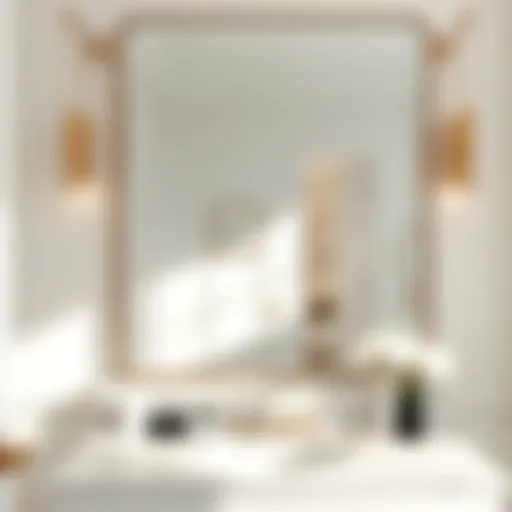Replace Your Bathtub with a Shower: A Complete Guide
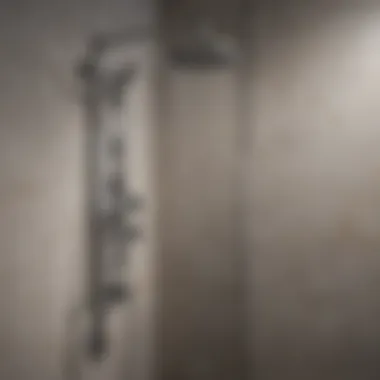

Intro
Replacing a bathtub with a shower can transform not only the functionality but also the aesthetic of your bathroom. In recent years, many homeowners have favored showers over bathtubs due to space constraints, lifestyle choices, or simply personal preference. Showers generally take up less space and offer a more streamlined look. Additionally, they can be more accessible for people of all ages.
This article aims to guide you through the entire process of removing your existing tub and installing a shower. It includes planning, preparation, necessary tools, and the installation process itself. Each step is laid out clearly to ensure a smooth renovation experience. With a focus on practicality and efficiency, this guide helps streamline your transition to a sleek new bathing space.
Trending Styles
Modern Minimalism
Modern minimalism has gained popularity in home design, especially in bathrooms. This style emphasizes clean lines, simplicity, and functionality. When replacing your bathtub with a shower, consider a frameless glass enclosure. Such enclosures create an illusion of space and ensure the bathroom remains visually open. Utilize high-quality materials, including matte black or brushed nickel fixtures, to enhance the overall contemporary look.
Cozy Rustic
On the other hand, if a warm, inviting atmosphere is what you desire, the cozy rustic style may be the right direction for you. This style often employs natural materials like wood and stone. When choosing your shower design, integrate wooden accents or use stone tiles to capture that rustic feeling. Walk-in showers can be designed with natural elements that create a spa-like environment, making the space relaxing and comfortable.
Color Palettes
Calming Neutrals
Neutral color palettes can enhance the tranquil feel of a bathroom. Shades like soft whites, beiges, and grays provide versatility while contributing to a serene atmosphere. These colors can easily be paired with various shower designs and fixtures, allowing you to maintain the high end look of your bathroom without overwhelming it.
Bold Accents
Conversely, bold accents can make a striking statement in your shower space. Consider incorporating dark tones or vibrant tiles to draw attention to the new shower area. These should be balanced against your neutral base to prevent a chaotic appearance. Whether you go for deep navy tiles or rich emerald green, these accents can provide character and style to your bathroom.
"A well-designed shower area can elevate your bathroom, making it not just functional but also a visual centerpiece."
With these trending styles and color palettes in mind, you can start planning your project effectively. In the following sections, we will explore the important preparations, removal of the old bathtub, and the step-by-step installation of the new shower.
Understanding the Conversion Process
When thinking about changing a bathtub for a shower, it is crucial to understand the conversion process. This phase serves as the foundation for the project and outlines several essential elements that impact the outcome. Recognizing how to approach this transition impacts both the functionality and aesthetic of your bathroom.
Defining the Objectives
Setting clear objectives is the first step in your journey. What are the goals? Do you want to maximize space or improve accessibility? Maybe you prefer a more modern look. By answering these questions, you will clarify what you wish to achieve. A well-defined objective guides the project and helps make decisions easier later on.
For example, if the aim is to create a more accessible shower, research universal design principles. Consider features like slip-resistant flooring or grab bars that enhance safety. If the focus is on aesthetics, explore different designs and colors that fit your personal style.
Evaluating Your Bathroom Layout
The importance of assessing your existing bathroom layout cannot be overstated. The conversion may seem straightforward, but challenges can arise due to the plumbing location, electrical outlets, or space constraints.
Begin by measuring your bathroom dimensions and taking note of where pipes and fixtures are located. This information will prove invaluable when planning your new shower setup.
Additionally, consider the flow of space. How does a new shower fit into the overall room? Will this lead to a more functional layout? For example, if you are moving the shower to a new corner, consider how this affects access to other fixtures such as toilets or sinks.
In summary, understanding the conversion process involves strategic thinking and planning. Defining specific objectives and evaluating the bathroom layout early on sets the stage for a smoother execution of your project.
Assessing Requirements
When embarking on a project to replace a bathtub with a shower, assessing requirements is a crucial step. This phase ensures that you are well-informed and prepared before initiating any work. The evaluation of your needs and constraints can prevent surprises during the installation process. Furthermore, it can help identify any necessary resources and compliance with local building standards.
Permits and Regulations
Understanding permits and regulations is fundamental in the conversion process. Many regions require permits to ensure that renovations comply with health, safety, and structural codes. Before starting, consult your local building authority or visit their website for specific requirements. This will help you avoid potential fines or complications later on.
In some cases, the installation of a shower unit may necessitate upgrades to plumbing or electrical systems to meet code standards. It is advisable to verify that the plumbing is capable to handle a new setup and if it meets local codes. The permitting process can be tedious, but it is a necessary aspect of home renovation.
Additionally, be aware of any zoning laws or homeowners’ association guidelines that may affect your project.
Budgeting for the Project
Effective budgeting for the project is essential for a successful renovation. It is not just about the cost of the shower unit itself but a comprehensive view of potential expenses. Begin by estimating costs for all materials, installation, and any necessary permits. The average costs can vary significantly depending on the type and style of the shower chosen.
Here are some key components to consider when creating your budget:
- Shower unit: The type you choose impacts the cost.
- Plumbing supplies: Pipes and fittings may need replacement or adjustment.
- Tiling materials: Wall tiles and floor tiles will add to the expense.
- Labor costs: If you are not doing it yourself, hiring a professional can increase the overall cost.
- Contingency fund: Set aside about 10-20% of your total budget to cover unexpected expenses.
All these factors contribute to the overall financial picture. By planning your budget carefully, you ensure that the project remains feasible and within your financial capacity, helping to avoid stress and overspending.
Planning Your Shower Space
When transitioning from a bathtub to a shower, careful planning of the new shower space is crucial. Not only does it impact the aesthetic appeal of the bathroom, but it also influences the daily functionality. The overall design and layout must accommodate the practical use of the shower while also aligning with personal preferences and lifestyle needs.
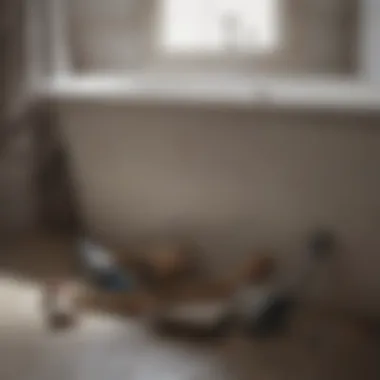

Key considerations include the available space, the shower type, water flow, and accessibility. Proper planning ensures an efficient use of space, which is especially vital when working with smaller bathrooms. Defining a clear vision helps avoid costly mistakes later down the line.
Choosing the Right Shower Type
Selecting the appropriate shower type plays a fundamental role in the overall transformation of the bathroom. Each option comes with unique characteristics that cater to distinct tastes and practical needs.
Walk-in Showers
Walk-in showers are spacious and offer an open feel. These types typically feature minimal barriers, allowing easy access. A key characteristic of walk-in showers is their seamless design, which can create a luxurious atmosphere in any bathroom. The lack of doors can also simplify cleaning tasks.
However, their installation might require significant changes to plumbing and potential structural modifications, which can increase project costs.
Advantages of walk-in showers include accessibility and a modern visual appeal, making them a popular choice for homeowners looking for an elegant solution.
Prefabricated Shower Kits
Prefabricated shower kits are a convenient and cost-effective option. They come ready to assemble and can significantly reduce installation time. A notable feature is that they are available in many sizes and designs, simplifying the selection process.
These kits minimize the need for extensive renovations, requiring less plumbing adjustment than custom solutions. However, they may lack the unique touch that custom installations provide. For homeowners focused on a rapid update with limited budget constraints, prefabricated kits might be the ideal solution.
Custom Shower Options
Custom shower options offer flexibility in design and functionality. Homeowners can dictate every aspect, from size to materials, creating a space that perfectly fits their vision. This customization is highlighted in the unique features—like multi-head shower systems or built-in shelving—that can enhance both beauty and utility.
Although custom options can come with a higher price tag and extended installation time, the long-term satisfaction often outweighs these challenges. For those willing to invest in their space, custom showers provide unparalleled personalization.
Selecting Fixtures and Finishes
The choices of fixtures and finishes further accentuate the new shower space. They contribute not just to aesthetics but also to how the shower functions. Selection should consider style, ease of use, and maintenance. Popular fixture choices include showerheads, faucets, and controls, each available in various designs that can enhance the overall theme of the bathroom.
Finishes such as tile types, colors, and textures also significantly influence the atmosphere. The combination of well-chosen fixtures and finishes can create an inviting, functional space that satisfies both form and function.
In summary, proper planning of the shower space involves thoughtful selection of shower types and fixtures. This careful preparation ensures that the final outcome meets both aesthetic desires and functional demands.
Necessary Tools and Materials
The successful removal of a bathtub and its replacement with a shower unit hinges not only on technique but also on using the right tools and materials. Selecting appropriate items safeguards against unnecessary complications and enhances efficiency during the process. Tools such as saws, screwdrivers, and pry bars each play a distinct part in the removal phase. Equally, understanding the materials required for installation impacts the long-term satisfaction with the new shower setup. Identifying these elements allows for a smoother transition from one bathing solution to another, minimizing the risk of errors while ensuring durability and functionality.
Essential Tools for Removal
Saw
A saw is crucial for cutting through various materials that could obstruct the removal of a bathtub. For this task, a reciprocating saw is often favored due to its versatility. This saw features a long blade that can pierce through both wood and metal, enabling it to handle challenging connections that may exist in older installations. Its capability to operate in tight quarters is a significant advantage, making it indispensable in confined bathroom spaces. One disadvantage may be the need for practice to use it safely and effectively. Overall, the reciprocating saw is highly regarded for this type of home renovation project.
Screwdriver Set
A screwdriver set is another vital tool in the removal process. These tools are designed to handle different types of screws, making them effective for detaching various fittings and fixtures related to the bathtub. Quality screwdrivers should possess comfortable grips and magnetized tips, enhancing control and precision. Often, a set that includes both flathead and Phillips head screwdrivers proves beneficial for handling diverse screws within the bathroom. One challenge with using screwdrivers is that they can sometimes strip screws if not applied correctly, but having a variety can mitigate this issue significantly.
Pry Bar
The pry bar serves the purpose of leveraging and prying off fixtures or parts attached to the bathtub. It is particularly useful in situations where tight spaces make traditional withdrawal challenging. A well-designed pry bar offers a flat end and a pointed end, which can assist in accessing different types of attachments and materials. However, one must use it carefully to avoid damaging the surrounding walls or floors, as leverage can sometimes result in unintended consequences. Overall, a pry bar is a reliable tool that enhances the removal process when used correctly.
Materials for Installation
In addition to tools, having the right materials is paramount when installing a new shower. Each component contributes to the overall function and aesthetics of the new bathing area. A quality shower base, suitable tiling materials, and reliable plumbing supplies are essential parts of this equation. Choosing the right materials ensures long-term usability and satisfaction with the finished product.
Shower Base
A shower base acts as the foundation for the new shower unit. It is pivotal as it defines the space and can affect drainage capabilities. Common materials for shower bases include acrylic and fiberglass, which are both lightweight and easy to install. A significant characteristic of a good shower base is its ability to withstand pressure without cracking. However, some may prefer the sturdiness of a tiled shower pan, though it generally requires more labor to install. This flexibility in material choice allows homeowners to tailor their showers to their personal needs while prioritizing function and durability.
Tiling Materials
Tiling materials play an essential role in not only the aesthetics of the shower but also its overall functionality. Tiles come in different materials such as ceramic, porcelain, or natural stone. Each type presents unique visuals and maintenance needs. Aesthetically, they can create a luxurious ambiance, which many homeowners seek. It is important to note that while some tiles offer resistance to water, others may stain easily and require upkeep. Therefore, understanding the pros and cons of different materials ensures a choice that fits the user’s lifestyle.
Plumbing Supplies
Plumbing supplies are fundamental in ensuring that the new shower works effectively. These supplies include pipes, connectors, and seals vital for a leak-free installation. It is crucial to select high-quality materials that can withstand water pressure and potential wear over time. Copper and PVC pipes are often used, each with its advantages and limitations. Copper is durable and resistant to corrosion, though it may be more expensive. PVC, on the other hand, is lightweight and easier to install but is not as robust in high temperatures. A careful choice of plumbing supplies can greatly influence the performance of the shower for many years to come.
Removing the Bathtub
Removing the bathtub is a critical step in converting your bathroom into a more functional space. This action not only allows for the installation of a shower unit but also can lead to improved aesthetics and space utilization. It’s essential to approach this task with a clear understanding of what is involved. Some benefits of removing a bathtub include the potential for increased accessibility and a streamlined look that is often more desirable.
Key Considerations:
- Safety measures must be in place to prevent injuries.
- Proper planning can help avoid damage to surrounding fixtures and walls.
- Understanding plumbing can be crucial to a successful removal.
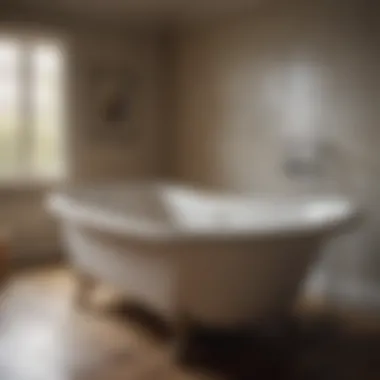

Preparing the Area
This step ensures that the removal process is efficient and minimizes complications.
Clearing Surrounding Space
Clearing the surrounding space is vital before removal. This involves removing any items such as toiletries, towels, or decorative pieces that may obstruct the area. It also provides a safer working environment, reducing the chance of accidents. A clean area allows for easy access to the bathtub as well as any tools needed for removal.
Benefits of Clearing Space:
- Enhances mobility during the project.
- Reduces the risk of damage to surrounding items.
- Improves visibility, helping to identify potential challenges more readily.
Shutting Off Water Supply
Shutting off the water supply is perhaps one of the most important preparatory steps. This action prevents any accidental leaks or flooding while the bathtub is being removed. Typically, the shut-off valves can be found near the water meter or behind access panels.
Key Aspect:
- This action safeguards the integrity of the bathroom and avoids extensive water damage.
Advantages of Shutting Off Water Supply:
- Ensures safety during the removal process.
- Reduces the likelihood of messy clean-up later.
- Helps to maintain control over the plumbing work that follows.
Detaching Bath Fittings
Detaching fittings such as faucets and spouts is essential before the bathtub can be removed. This usually involves using appropriate tools to unscrew or unfasten these components. Ensure that you keep track of all pieces since they may be reused during the shower installation.
Extracting the Bathtub
This process requires careful attention to detail.
Dealing with Heavy Materials
Bathtubs are often made from hefty materials such as cast iron or fiberglass. Handling these materials requires additional caution. Proper lifting techniques or equipment may be necessary to avoid injury. It is important to secure the bathtub properly to prevent tipping or accidental drops.
Key Characteristic:
- Heavy materials require team effort or machinery for safe extraction.
Advantages:
- Proper handling ensures both safety and the potential for reuse of materials in other projects.
Handling Drainage Connections
When it comes to handling drainage connections, knowing how these systems work can be beneficial. Disconnecting the drain involves unscrewing the drain cover and removing the trap. This step must be handled with care to avoid damaging the plumbing pipes underneath.
Key Feature:
- Understanding the connections can help prevent issues during installation of the new shower.
Advantages:
- Proper detachment of drain systems ensures a smoother transition to the new setup.
Important Note: Proper preparation and understanding of the removal process can greatly reduce the time and effort involved in replacing your bathtub with a shower.
Preparing for the Shower Installation
Preparing for the shower installation is a crucial phase in the overall conversion process. This step ensures that all aspects of the new shower unit meet your specific needs while aligning with local building codes. The importance of this preparatory phase cannot be underemphasized as it can greatly influence the success of the installation and the usability of the new space.
One of the key benefits of preparing for this installation is the opportunity to reinforce the shower area. This support can prevent future issues such as leaks or structural weaknesses. It allows for a more reliable foundation for your shower base and walls. Therefore, checking the surrounding frames and walls helps prevent potential structural problems once the shower unit is in place.
Additionally, adjusting plumbing lines is another important consideration. Existing plumbing may not perfectly align with the new shower configuration. Ensuring correct alignment is vital for optimal function during use. Misplacing plumbing can lead to excessive leaks or functionality issues down the line. Thus, strategically assessing and modifying plumbing lines facilitates a smoother installation process.
By properly preparing the shower space, you can ensure a longer lifespan and enhanced performance of your new unit.
Engaging in these preparatory actions not only saves time during the installation but also safeguards against future costly repairs. Prepare well, and the result will be both functional and aesthetically pleasing.
Reinforcing the Shower Area
Reinforcing the shower area involves evaluating and enhancing the structural integrity of the installation site. This process typically includes adding support beams or ensuring that the flooring is level and stable. Good reinforcement prevents sagging or movement over time, making the shower safer and more durable.
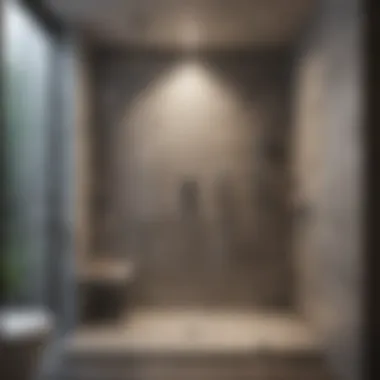

A stable base aids in maintaining the correct slope needed for proper drainage, reducing the likelihood of water pooling. It is prudent to assess existing wall structures as well; they must be capable of supporting heavy tiles or glass enclosures, depending on your design choices.
Adjusting Plumbing Lines
Adjusting plumbing lines is an essential task that requires careful planning. This adjustment ensures that water supply lines and drainage systems align perfectly with the new shower setup. First, shut off the water supply and drain any existing pipes to avoid spills.
Next, remove any necessary wall panels or access points to examine the plumbing layout clearly. It may involve rerouting pipes and ensuring that everything functions smoothly with the shower fixtures. Notably, the drainage must slope correctly to avoid stagnant water, and all connections should be sealed tightly to prevent leaks.
Finally, before closing up walls or covering the plumbing, it is advisable to test the lines for leaks. A simple check can save much hassle later, ensuring that the shower installation goes smoothly and operates efficiently.
Installing the Shower Unit
Installing the shower unit is a pivotal step in the conversion process from bathtub to shower. The way you handle this installation significantly influences both the functionality and aesthetics of the new bathing area. Proper installation results in a seamless integration of the shower unit into your bathroom, providing you with ease of use and long-term satisfaction.
This stage encompasses several key elements, including the setting of the shower base, installation of the walls, and fitting of various fixtures. Each element plays a role in ensuring that the shower unit operates efficiently while enhancing the overall look of the space.
As such, careful attention to detail during this phase can prevent future issues such as leaks, mold growth, or poor water drainage. Moreover, selecting the right materials and applying the correct installation techniques can lead to a durable and visually appealing shower unit.
Setting the Shower Base
The first step in this installation phase is to set the shower base. The base serves as the foundation for your shower and must be level and secure to prevent any movement over time. Start by ensuring that the subfloor is sturdy and free of any debris. If the floor is uneven, temporary shims or a patching compound can help create a level surface.
Once the area is prepared, follow the manufacturer’s instructions to position the shower base accurately. You may need to connect drainage pipes at this stage. It is vital that this connection is watertight. After fitting the base, a level must be used again to check that it is perfectly horizontal. If not, minor adjustments can be made before permanently adhering the base with a suitable adhesive.
Installing Shower Walls
Installing shower walls follows the successful setting of the shower base. The walls serve not only as barriers against water but also contribute to the overall aesthetic of the bathroom. There are various materials to choose from, including tiles, acrylic panels, or fiberglass sheets. The choice depends on your style preference and budget.
When installing the walls, measure carefully and cut the material as needed. Start from one corner and work your way around, ensuring every piece is securely fastened to the studs in the wall. For tiled walls, start with a level reference line before placing tiles to ensure even spacing. Apply waterproof adhesive as you go, and be sure to leave spaces for grout and caulk, which help to seal any gaps.
Fitting Fixtures and Accessories
The final step in the installation process involves fitting the fixtures and accessories. This includes the showerhead, faucet, and any additional storage or decorative elements you may prefer. Choosing high-quality fixtures is important. They contribute to both the functionality and aesthetic of your shower space.
Begin by installing the plumbing fixtures according to the manufacturer’s guidelines, ensuring that supply lines are not crossed or intertwined. Once plumbing is secure, attach the showerhead and any other components, like shelves or grab bars.
After all fixtures are installed, check for leaks by running the shower for a few minutes. Look for drips or moisture around joints. If any issue arises, addressing it immediately is critical to maintaining integrity of your new installation.
"Proper installation of the shower unit reduces long-term repairs and enhances daily usage satisfaction."
In summary, the installation of the shower unit is fundamental for a successful transition from a bathtub to a shower. Focused attention on setting the base, installing walls, and fitting fixtures assures a functional and appealing bathing area.
Finishing Touches
Finishing touches are an essential aspect of any renovation project, particularly when converting a bathtub to a shower. This stage involves not just aesthetic enhancements but also crucial elements that ensure durability and functionality. Completing this phase properly can significantly impact the overall success and longevity of the installation.
Sealing and Waterproofing
Sealing and waterproofing are two vital steps that cannot be overlooked during the finishing touches. These processes help protect the surrounding areas from moisture, which can cause severe damage like mold and mildew growth. Additionally, maintaining the integrity of the structure is critical since bathrooms are prone to high humidity.
When sealing, it is important to select a high-quality silicone caulk for corners and edges where the shower meets the wall. Apply a consistent bead along the seams, using a caulking gun. Don’t forget to smooth it out for a clean finish, ensuring it adheres well. The waterproofing membrane should cover the entire shower area, acting as a barrier against leaks. Various types of membranes exist, such as liquid-applied membranes or sheet membranes, each with their specific advantages.
Testing the Installation
After sealing and waterproofing, testing the installation is the next crucial step. This phase guarantees that everything operates as intended before finalizing the project. It involves several checks, starting with ensuring that all fixtures are functioning correctly.
Make sure to run water through the shower for several minutes to check for leaks. If leaks are found, it’s essential to address them promptly to avoid future problems.
Additionally, assess the water pressure and drainage. Proper water flow should foster a comfortable shower experience, avoiding issues like slow drainage or water pooling.
Post-Installation Considerations
After removing the bathtub and installing the new shower unit, it is crucial to take a moment to consider a few key elements that will ensure long-term satisfaction and functionality of your new setup. Post-installation considerations encompass maintenance, care, and an evaluation of how well the new shower meets your needs. These factors not only enhance your bathing experience but also help in preserving the integrity of your investment.
Maintenance and Care
Proper maintenance is vital to prolong the life of your new shower. Regular cleaning of the shower surface and fixtures prevents the buildup of soap scum and mildew, which can lead to unsightly stains and unpleasant odors. Consider using mild, non-abrasive cleaners to avoid damaging the surfaces.
- Routine Checks: Conduct periodic inspections of the plumbing and fixtures to catch any leaks early.
- Sealant Maintenance: If you’ve used tiles, ensure that the grout and caulking around your shower are intact. Reapplication may be necessary every few years to maintain a waterproof barrier.
- Ventilation: Keep the bathroom well-ventilated to prevent excessive moisture which can encourage mold growth. A good quality exhaust fan can be quite beneficial.
Evaluating the New Setup
After using your new shower for a period, take time to evaluate how it fits within your daily routines. Consider the following aspects:
- Functionality: Are the fixtures functioning as desired? Do they provide adequate water pressure and temperature control?
- Comfort: Is the space comfortable for your needs? Assess if the shower head height, width, and overall layout work well for you.
- Aesthetic Appeal: Review the visual appeal of the new setup. Does it align with your original intentions? Does it enhance the overall appearance of your bathroom?
There may be adjustments needed after initial use. Don’t hesitate to make small changes to improve your user experience. Taking the time to properly maintain and evaluate the new setup contributes to a more enjoyable and functional bathing environment.
Regular care and a thorough evaluation can significantly impact the longevity and satisfaction of your new shower unit.



